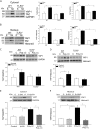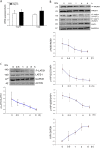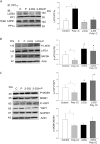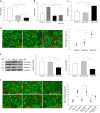TLR3 Mediates Repair and Regeneration of Damaged Neonatal Heart through Glycolysis Dependent YAP1 Regulated miR-152 Expression
- PMID: 29358670
- PMCID: PMC5943401
- DOI: 10.1038/s41418-017-0036-9
TLR3 Mediates Repair and Regeneration of Damaged Neonatal Heart through Glycolysis Dependent YAP1 Regulated miR-152 Expression
Abstract
The present study investigated whether TLR3 is required for neonatal heart repair and regeneration following myocardial infarction (MI). TLR3 deficient neonatal mice exhibited impaired cardiac functional recovery and a larger infarct size, while wild type neonatal mice showed cardiac functional recovery and small infarct size after MI. The data suggest that TLR3 is essential for the regeneration and repair of damaged neonatal myocardium. In vitro treatment of neonatal cardiomyocytes with a TLR3 ligand, Poly (I:C), significantly enhances glycolytic metabolism, YAP1 activation and proliferation of cardiomyocytes which were prevented by a glycolysis inhibitor, 2-deoxyglucose (2-DG). Administration of 2-DG to neonatal mice abolished cardiac functional recovery and YAP activation after MI, suggesting that TLR3-mediated regeneration and repair of the damaged neonatal myocardium is through glycolytic-dependent YAP1 activation. Inhibition of YAP1 activation abolished Poly (I:C) induced proliferation of neonatal cardiomyocytes. Interestingly, activation of YAP1 increases the expression of miR-152 which represses the expression of cell cycle inhibitory proteins, P27kip1 and DNMT1, leading to cardiomyocyte proliferation. We conclude that TLR3 is required for neonatal heart regeneration and repair after MI. The mechanisms involve glycolytic-dependent YAP1 activation, resulting in miR-152 expression which targets DNMT1/p27kip1.
Conflict of interest statement
The authors declare that there are no competing financial interests.
Figures









Similar articles
-
Melatonin promotes cardiomyocyte proliferation and heart repair in mice with myocardial infarction via miR-143-3p/Yap/Ctnnd1 signaling pathway.Acta Pharmacol Sin. 2021 Jun;42(6):921-931. doi: 10.1038/s41401-020-0495-2. Epub 2020 Aug 24. Acta Pharmacol Sin. 2021. PMID: 32839503 Free PMC article.
-
Yes-associated protein isoform 1 (Yap1) promotes cardiomyocyte survival and growth to protect against myocardial ischemic injury.J Biol Chem. 2013 Feb 8;288(6):3977-88. doi: 10.1074/jbc.M112.436311. Epub 2012 Dec 30. J Biol Chem. 2013. PMID: 23275380 Free PMC article.
-
miR-206 Mediates YAP-Induced Cardiac Hypertrophy and Survival.Circ Res. 2015 Oct 23;117(10):891-904. doi: 10.1161/CIRCRESAHA.115.306624. Epub 2015 Sep 2. Circ Res. 2015. PMID: 26333362 Free PMC article.
-
MicroRNAs: A Neoteric Approach to Understand Pathogenesis, Diagnose, and Treat Myocardial Infarction.J Cardiovasc Pharmacol. 2021 Dec 1;78(6):773-781. doi: 10.1097/FJC.0000000000001141. J Cardiovasc Pharmacol. 2021. PMID: 34882110 Review.
-
The role of microRNAs in cardiac development and regenerative capacity.Am J Physiol Heart Circ Physiol. 2016 Mar 1;310(5):H528-41. doi: 10.1152/ajpheart.00181.2015. Epub 2015 Dec 23. Am J Physiol Heart Circ Physiol. 2016. PMID: 26702142 Free PMC article. Review.
Cited by
-
Prognostic Prediction of Cytogenetically Normal Acute Myeloid Leukemia Based on a Gene Expression Model.Front Oncol. 2021 May 27;11:659201. doi: 10.3389/fonc.2021.659201. eCollection 2021. Front Oncol. 2021. PMID: 34123815 Free PMC article.
-
Progress of Single-Cell RNA Sequencing Technology in Myocardial Infarction Research.Front Cardiovasc Med. 2022 Feb 17;9:768834. doi: 10.3389/fcvm.2022.768834. eCollection 2022. Front Cardiovasc Med. 2022. PMID: 35252379 Free PMC article. Review.
-
Cysticercus pisiformis-derived novel-miR1 targets TLR2 to inhibit the immune response in rabbits.Front Immunol. 2023 Jul 25;14:1201455. doi: 10.3389/fimmu.2023.1201455. eCollection 2023. Front Immunol. 2023. PMID: 37559722 Free PMC article.
-
Activation of Nrf2 by miR-152 Inhibits Doxorubicin-Induced Cardiotoxicity via Attenuation of Oxidative Stress, Inflammation, and Apoptosis.Oxid Med Cell Longev. 2021 Jan 26;2021:8860883. doi: 10.1155/2021/8860883. eCollection 2021. Oxid Med Cell Longev. 2021. PMID: 33574984 Free PMC article.
-
Resveratrol attenuates cerebral ischaemia reperfusion injury via modulating mitochondrial dynamics homeostasis and activating AMPK-Mfn1 pathway.Int J Exp Pathol. 2019 Oct;100(5-6):337-349. doi: 10.1111/iep.12336. Epub 2019 Dec 22. Int J Exp Pathol. 2019. PMID: 31867811 Free PMC article.
References
Publication types
MeSH terms
Substances
Grants and funding
LinkOut - more resources
Full Text Sources
Other Literature Sources
Medical
Molecular Biology Databases

